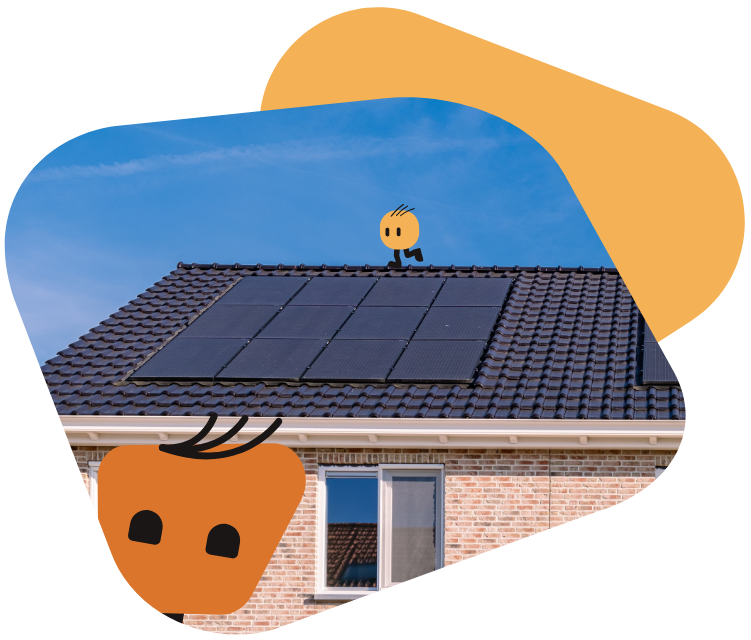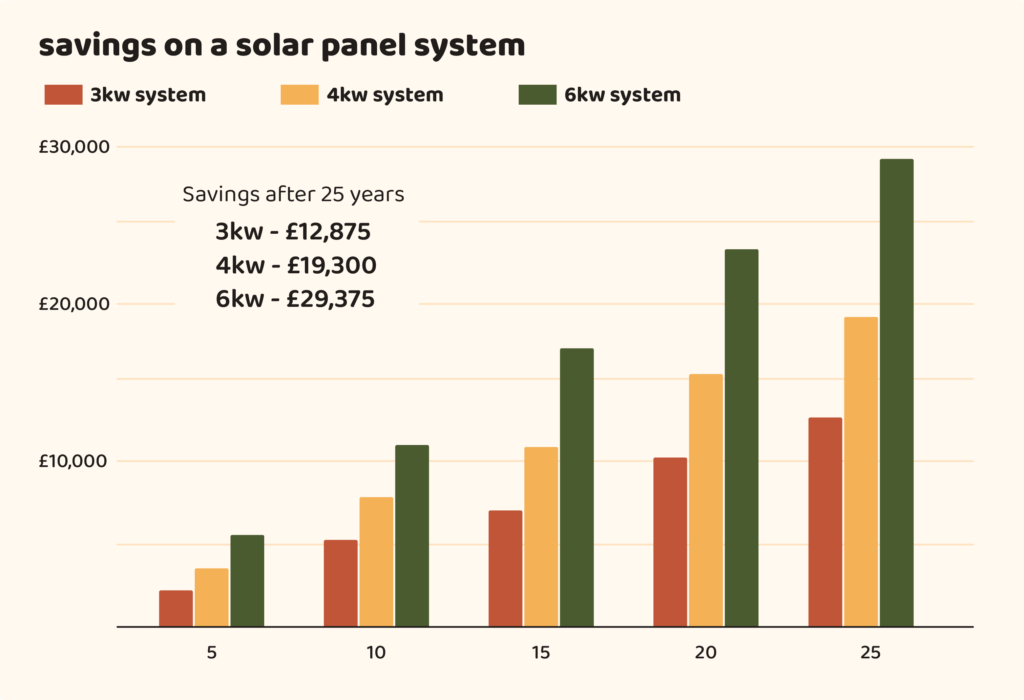As a homeowner, you may have wondered, “Are solar panels worth it?”
Well, the short answer is yes!
Investing in solar panels is worth it, especially with the rise in electricity costs and working from home. Solar panels absorb the sun’s energy to generate electricity, which can significantly reduce your electricity bills. In 2023, there were, on average, 20,000 solar panel installations per month (Source: MSC, 2023), so if you’re thinking about getting solar panels, now is the time. In this blog, we will delve into why solar panel installation is a viable option for UK residents. We aim to provide a comprehensive analysis that will help you make an informed decision. Whether you’re motivated by environmental concerns, the prospect of energy independence, or the financial returns

the key points:
- Solar energy can decrease your electricity expenses across the UK, regardless of your location.
- The period to reach a break-even point on average is between 5-10 years, but this can vary due to multiple factors.
- Utilising battery storage to maximise the usage of your solar generation. This is often referred to as “self-consumption”.
- Selecting a solar or EV-specific tariff with your energy provider.
- These give you off-peak rates to charge your EV or batteries, which you can use while the peak rates are in effect.
- Selling surplus energy back to the grid through the Smart Export Guarantee (SEG), which ranges between 5 and 30p per kWh, is a great way to increase your savings and reduce payback.
- Alterations in your energy consumption habits can significantly influence figures.
- The performance and efficiency of your solar panel system, which is heavily influenced by its type and quality, play a crucial role in its financial viability.
- In recent years, the cost of solar panel systems has declined, making the transition to renewable energy more affordable than ever.
The rise of Solar Panel Installation in the UK
In the past decade, the UK has witnessed a remarkable surge in the adoption of solar technology. It feels like we’re all part of this big, green revolution, making strides towards a cleaner and more sustainable future. From the rolling hills of the countryside to the bustling city rooftops, solar panels are popping up everywhere, and it’s not hard to see why.
This growth isn’t just by chance; it’s thanks to a mix of savvy tech improvements, more affordable prices, and a rise in people wanting to do their bit for the planet. Plus, the government’s been on board, rolling out incentives like the Smart Export Guarantee (SEG) that pays you for any extra solar energy you send back to the grid. Not only are we cutting down on our carbon footprint, but we’re also seeing some savings on our energy bills.
The drive towards solar power has been fueled by more than just saving a few quids or getting paid for extra energy. It’s about making a change for the better. We’re all too aware of the impact of traditional energy sources on our planet, and solar offers a shining light towards a more sustainable way of living. Plus, with energy prices going up and down like a yo-yo, having your own solar setup gives you a bit more control and peace of mind.
How much does Solar Panel Installation cost?
The cost of solar panels in the UK typically ranges from £5,000 – £13,000, including supply and installation (Source: Greenmatch, 2024). However, here at Residential Solar, our costs start from £3,995.
According to a survey (Source: Which, 2024) of over 1,000 solar panel owners, the most commonly installed system capacity ranges from 3.6kWp to 4kWp. On average, these systems produce 3,750kWh of electricity annually for their owners. This system costs around £9,000 – £10,000, including supply and install (Greenmatch).
But, the investment required for a solar PV system can vary and is influenced by several factors, including:
- The overall size of the system and the number of panels installed.
- The specific type of solar panels used.
- The nature of the property on which the panels are to be mounted.
- The quality of the inverter and other essential components.
Therefore, we have outlined the cost of different solar panel systems and their yearly energy output so you can estimate costs. (Source: Greenmatch, 2024. The figures in this table are based on systems using 350W panels).
Solar Panel Costs and Output by System Size
| System Size | Yearly Energy Output | Estimated Savings |
|---|---|---|
| 3 kW Solar System | 2,550 kWh | £7,000 – £8,000 |
| 4 kW Solar System | 3,400 kWh | £9,000 – £10,000 |
| 5 kW Solar System | 4,250 kWh | £11,000 – £12,000 |
| 6 kW Solar System | 5,100 kWh | £12,000 – £13,000 |
The installation of solar panels represents a significant financial commitment; however, it is crucial to view this expenditure as an investment rather than a mere cost. Over time, solar panels can generate considerable savings on electricity bills, thereby offering a tangible financial return. The essence of this investment lies in its ability to transform sunlight into electricity, effectively reducing the homeowner’s dependence on the national grid and the volatile energy market.
Want an Accurate Estimate of Costs and Savings based on your property? Head to our Online Calculator

The Pros and Cons of Solar Energy
The bright side of solar panels
- You can save money on your energy bills over time.
- You will be championing the environment and reducing your carbon footprint.
- Solar panels are great at producing power, but they don’t like to shout about it; they are entirely silent.
- Claiming your energy independence, you will become freer from the national grid. This means more predictability in your energy bills.
- Solar panels are low maintenance, so they do not need checking on 24/7.
- You can sell excess electricity via the Smart Export Guarantee (SEG).
The cloudy days of solar panels
- The upfront cost of getting solar panels can be a bit of a gulp moment. But think of it as an investment in your future.
- Solar panels need their space to shine – literally. You’ll need a good chunk of roof real estate that gets plenty of sunlight.
- You will need a storage battery to store electricity for use at night; this is an additional cost.
- Not all roof types are suitable. Ideally, your roof should be facing southwards at a 30-45 degree angle – although east and west-facing solar panels can work well too.
- You will generate less electricity in cloudy weather.
The advantages of solar panels are significant, making them a wise investment if the initial cost is within your budget. On average, households with solar panels enjoy annual energy bill savings of £537 (Source, The Eco Experts, 2023).
Moreover, if you decide to share some of that solar love back to the grid through the Smart Export Guarantee (SEG) – you could pocket an extra £159 every year (Source, The Eco Experts, 2023). All while doing your bit to cut down carbon emissions and make our planet a happier, greener place.
However, it’s important to note that solar panels require considerable space. So, if your roof isn’t big enough to catch the rays needed to power your home, you’ll still need a bit of help from the grid. Nonetheless, any reduction in grid dependence is a positive step towards energy independence.
Finally, solar energy production is limited to daylight hours. To use solar power at night, consider getting a storage battery. These batteries typically cost around £4,500 and have an average lifespan of 12.5 years, meaning you might need to purchase two during the life of your solar panel system (Source, The Eco Experts, 2023).
when is the break even point with solar panels?
In the UK, the typical break-even time for solar panels is 11 – 15 years (Source: Greenmatch, 2024). However, various factors influence this, such as installation costs, the export tariff, energy consumption, and current electricity prices.
| System Size | System Cost | Annual Savings | Break Even Point |
|---|---|---|---|
| 3 kW | £7,000 – £8,000 | £515 | 14 years |
| 4 kW | £9,000 – £10,000 | £770 | 12 years |
| 6 kW | £12,000 – £13,000 | £1,175 | 11 years |
However, your location affects your break even point. Sunlight varies across the UK, meaning solar panels in some regions will produce more energy than others. As a result, the time it takes to recoup your investment – the break-even point – differs from one area to another. Check out how each region stacks up below.
| Region | Years to break even |
|---|---|
| South Wales | 11.1 |
| South West England | 11.1 |
| South East England | 11.7 |
| South England | 11.7 |
| East Anglia | 11.7 |
| North Wales | 12.9 |
| North West England | 12.9 |
| Midlands | 13.3 |
| Northern Ireland | 8.6 |
| East England | 13.5 |
| North East England | 13.5 |
| East Scotland | 14.4 |
| West Scotland | 14.6 |
| North Scotland | 15.9 |
Reduce Solar Panel Costs with SEG Payments

| Household size | Per type of system | Electricity generated per year | Average energy consumption | Income earned with SEG | Total annual savings with SEG | Savings after 25 years with SEG |
|---|---|---|---|---|---|---|
| 1-2 bedrooms | 3kW | 2,550kWh | 1,800kWh | £41.25 | £555 | £13,875 |
| 2-3 bedrooms | 4kW | 3,400kWh | 2,700kWh | £38.50 | £810 | £20,250 |
| 2-3 bedrooms | 5kW | 4,250kWh | 2,700kWh | £85 | £855 | £21,375 |
| 4-5 bedrooms | 6kW | 5,100kWh | 4,100kWh | £55 | £1,230 | £30,750 |
The table data is based on an example SEG tariff rate of 5.5p/kWh. The average energy consumption figures were taken from Greenmatch, 2024.
In the UK, there’s a nifty way to make going solar even sweeter for your wallet, thanks to solar panel grants like the Smart Export Guarantee (SEG). The SEG is a government-supported initiative that launched in January 2020. It’s pretty simple: if your solar panels are basking in the sun and producing more power than you need, you can sell the extra juice back to the national grid. You’re basically getting paid for being eco-friendly!
The cherry on top of your solar adventure is the long-term savings, especially with the SEG giving you a financial boost. Over 25 years, you could be looking at savings between £13,900 and £30,750. That’s a lot of extra cash in your pocket, all thanks to your decision to go solar and the SEG. The exact amount you save will depend on your setup and the tariff you’re on, but either way, it’s a win-win.
More information about the Smart Export Guarantee can be found in this guide on Ofgem’s website.
how much money will you save with solar panels?
Your solar panels will generate electricity you can use at home, allowing you to buy electricity from the grid. This will save you hundreds of pounds per year, and it gets even better. Below is a table showing the savings you could make over 25 years on a SEG tariff.

*The figures in this graph are calculated based on the national average household energy consumption (Greenmatch, 2024), the example SEG tariff rate (5.5p/kWh), and the current price of electricity (Greenmatch, 2024). The graph makes a broad estimate, and figures may vary according to the size, type, and quality of the solar panel system, as well as export tariffs.
will solar panels become a better investment in the future?
Yes, because electricity will become more expensive and solar panels will get cheaper, but you should install solar panels sooner rather than later. Here’s why…
The Eco Experts (Source, 2023) have worked out that if the cost of solar decreases from their current rate by 24.7% by 2030 and 45% by 2040 (based on government data), by 2025, you would be paying 59.9% less than you would if you bought solar panels today.
However, according to the Climate Change Committee, the cost of electricity is high and only rising. By 2030, consumers’ electricity costs will increase by 24%. That means that every year you’re not using solar panels to reduce your intake from the National Grid, you’ll be paying higher and higher electricity bills.
To put this into perspective, the average three-bedroom household could save around £1,000 on the price of solar panels by waiting until 2030 – but will have paid £628 more in electric bills and missed out on £4,145 in solar power savings. Overall, you would lose £3,587 by waiting – and that’s without even factoring in the Smart Export Guarantee. Therefore, it is a better idea to buy solar panels now and start saving money straight away.
Get an Instant Quote using our Online Calculator



